
How to pair Dipladenia?
Our ideas for a sunny exhibition
Contents
Climbing plant with remarkable summer flowering, dipladenia (or mandevilla) is mainly used as an annual plant due to its low hardiness. It is indeed a must-have for brightening up cemeteries. In the colder regions, you can grow it in a pot to bring it indoors during winter. It is only in mild climates – where frosts are not a concern – that it can be planted in the ground. Well-exposed to full sun, it reveals star-shaped trumpet flowers in solid colours: bright white, light pink or fuchsia, intense red, or vibrant yellow. Native to South America, this voluble plant, also known as Brazilian Jasmine, can be showcased in various settings: on a support with other climbing plants, in a pot with annuals or perennials, or planted in a border. Discover our ideas for successfully combining dipladenias in the garden, on the terrace, or the balcony!
To dress a wall alongside other climbing plants
You can perfectly combine dipladenia with other climbing plants in sunny spots to create a small green screen, simply to add colour to a façade, or to hide an unsightly wall. Dipladenia can also be used to adorn a pergola or an arch. Flowering in warm hues pairs well together. For example, consider the yellow dipladenia from the Diamantina ‘Opale Citrine 2.0’ series, which reaches a height of about 85 cm. Intertwine it with the black-eyed Susan in orange, which climbs to approximately 2 m tall, or with a nasturtium, such as the Tropaeolum majus ‘Red Wonder’, showcasing bright red flowers.

Mandevilla and Thunbergia alata ‘Sunny Susy New Orange’
You can also create a beautiful contrasting duo by pairing dipladenia Mandevilla (x) sanderi Diamantina ‘Jade Scarlet’ with scarlet red flowers alongside the Sollya heterophylla ‘Ultra Blue’, which offers beautiful ultramarine blue flowers from June to September, or with the Hardenbergia violacea ‘Warrabura’, displaying its purple flowers from February to June. Try another combination by decorating your support with the dipladenia Diamantina ‘Quartz Pink & Yellow’ in fuchsia pink, mixed with the blue flowers of Cape leadwort. All these plants are tender and do not withstand winter frosts. They are therefore used as annuals in regions with harsh winters. In warmer regions sheltered from frost, dipladenia can remain in the ground. To accompany your dipladenia, also consider bougainvillea, morning glory, or passionflower.
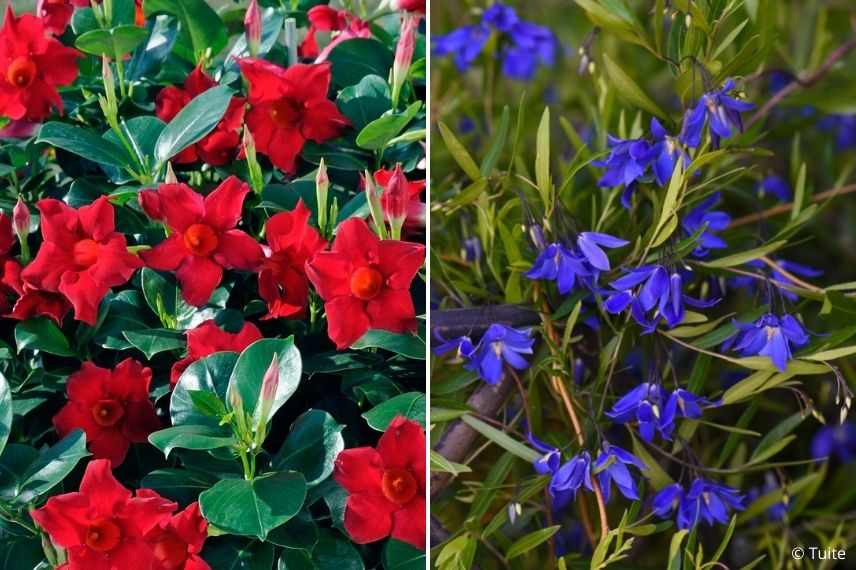
Dipladenia Diamantina ‘Jade Scarlet’ and Sollya heterophylla ‘Ultra Blue’
Pair with red to make a striking impression
The intense red of dipladenia is excellent for enlivening pot displays. The dipladenia ‘Jade Red’ performs well in pots. The garden verbena red and white Verbena hybrida ‘Estrella Voodoo Red Star’ is a good companion for our mandevilla. At the front of the pot, allow a white mini petunia to cascade, such as the Calibrachoa ‘Superbells Unique White’. This adds a bright touch to the display. However, you can also opt for a plant with variegated white foliage, like the Plectranthus coleoides ‘Variegatus’. Be aware that grey pairs well with red. The foliage of Helichrysum petiolare ‘Silver’, the silver cineraria ‘Silver Dust’, and Festuca glauca ‘Elijah Blue’ fit perfectly here. Set back in your pot, you might also choose to install the Imperata cylindrica ‘Red Baron’, a grass whose upright green foliage ignites with burgundy red tips.
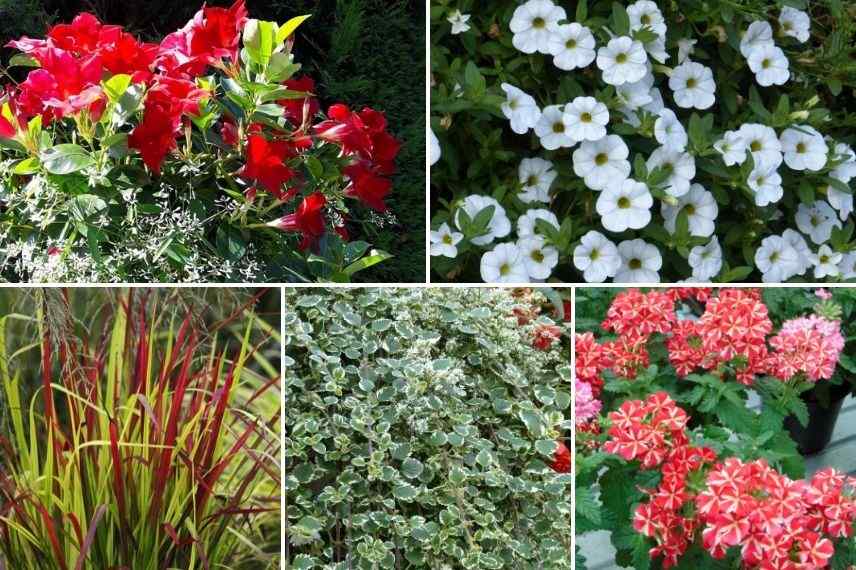
Dipladenia Diamantina ‘Jade Red’, Calibrachoa ‘Superbells Unique White’, Imperata ‘Red Baron’, Plectranthus coleoides ‘Variegata’ and Verbena ‘Voodoo Red Star’
Discover other Dipladenia
View all →Available in 1 sizes
Available in 0 sizes
Available in 2 sizes
Available in 1 sizes
Available in 2 sizes
Available in 1 sizes
Available in 1 sizes
Available in 1 sizes
Available in 1 sizes
Available in 1 sizes
Elegance for a monochrome planter
The hybrid mandevilla Diamantina ‘Jade White’ is well-suited for a monochrome white summer display. In a large planter, it can easily be paired with the small ornamental tobacco ‘Perfume White’ featuring star-shaped trumpet flowers. The euphorbia ‘Diamond Frost’ helps to lighten the planting with its tiny white flowers forming a fluffy cushion. We can also mention the alyssum ‘Snow Crystals’ bearing a multitude of small bouquets of white flowers. Add volume to the arrangement by including an upright and thread-like plant, such as the ‘Little Bunny’ Chinese fountain grass or the Stipa pennata. In summer, this grass bears silver spikes that perfectly complement this combination.
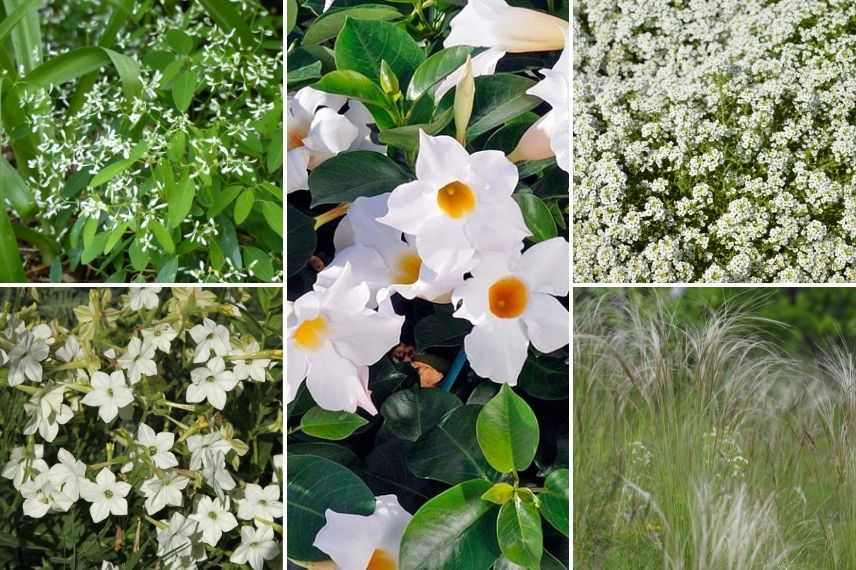
Chamaesyce ‘Diamond Frost’, Dipladenia Diamantina ‘Jade White’, Lobularia maritima ‘Snow Crystals’, Nicotiana sanderae ‘Perfume White’ and Stipa pennata
Read also
10 tips to successfully grow dipladeniaRomanticism for a composition in soft tones
The soft hue of the Mandevilla (x) sanderii Diamantina ‘Jade Rose’ allows for romantic flower combinations. Unveiling its light pink flowering from June to October, plant it in a large container and pair it with white lobelia ‘Anabel Snow White’. Perfect for pot planting, geraniums offer a wide range of soft colours. Add a trailing plant to the front of your display. Thriving in sunlight, petunias are now available in many colours. The most original varieties boast stunning double flowers, such as the ‘Amarena Twist’ mauve pink petunia or the purple ‘Tumbelina Priscilla’, as well as flowers punctuated with small white spots, which together resemble a constellation (Petunia ‘Lavender Sky’). With their decorative and lush foliage, ipomoeas are remarkable in flowering pots. Notable is the ‘Sweet Caroline Light Green’ ipomoea with palmate, pointed leaves tinted in a bright green, as well as the ‘Sweet Caroline Bronze’ offering greenish, purplish, and bronze hues. Don’t forget common ivy, which is also a typical plant of romantic gardens. To border your pot with a cascade of leaves, opt for the cultivar ‘Glacier’ with its silver-variegated green-grey foliage.

Petunia ‘Tumbelina Priscilla’, Hedera helix ‘Glacier’, Lobelia ‘Hot White’, Mandevilla and Petunia ‘Amarena Twist’
In isolation in a pot scene
If you’re not a fan of floral arrangements, there’s always the option of planting in isolation. For a successful change of scenery, grow your dipladenia alone in a pot and surround it with tropical-looking potted plants. Pair the exotic flowers of the dipladenia with the soft, linear foliage of the cordyline that resembles a palm tree. The colours are very varied, so indulge yourself! Compact agapanthuses offer beautiful spherical flowerings in white, blue, and pink. The foliage can sometimes be variegated, as seen in the agapanthus ‘Golden Drop’, which can be used in pots. In warm tones, cannas set your terrace ablaze with their tropical-looking flowers. Native to Australia, the grevillea requires good sunlight, just like the dipladenia. In a large container at the back of this display, place a dwarf banana tree with opulent foliage (Musella lasiocarpa) or a miniature palm such as the Trachycarpus wagnerianus. The less hardy plants will need to be protected from frost in colder regions. So, make sure to have a storage space to accommodate them in winter.
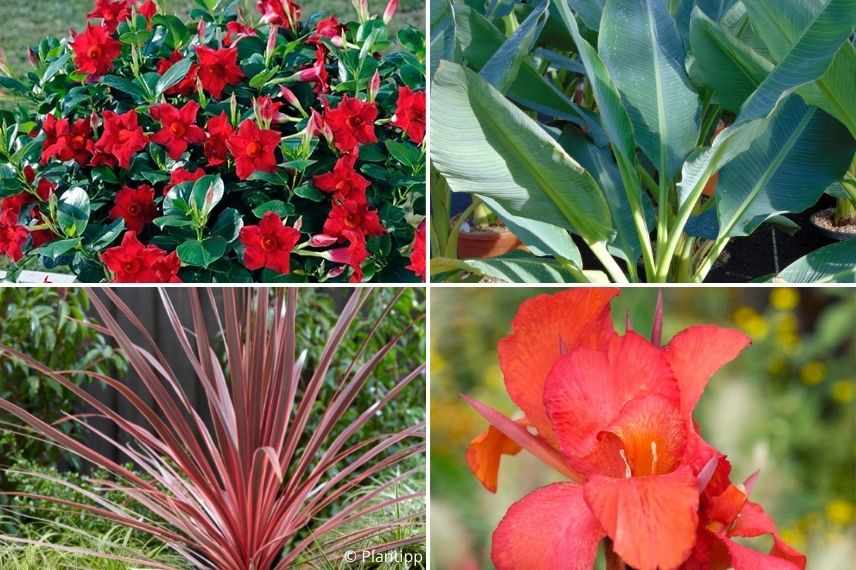
Dipladenia Diamantina ‘Jade Scarlet’, Musella lasiocarpa ‘Lotus d’Or’, Cordyline ‘Charlie Boy’ and Canna ‘Red King Humbert’
In a border in a Mediterranean climate garden
In regions where the risk of frost is very low, dipladenia has its place in the ground, where it forms a bush if not staked. In a south-facing garden, this tender plant benefits from the sun and warmth it particularly enjoys. Position your plants according to their height, creating different strata. The aromatic and fragrant plants are welcome at the front for easy harvesting: thyme, rosemary, sage, lavender. In this low-maintenance garden, the succulents thrive well: sedum, aloe, agave, or the spiny opuntia. To protect the dipladenia from the wind, accompany it with large exotic-looking plants such as the watsonia or the bird of paradise (Strelitzia reginae) often found in tropical gardens. Among the shrubs, cistus offers a beautiful summer flowering of single flowers. Native to the Mediterranean, the common myrtle ‘Tarantina’ scents the garden with its small white flowers with numerous stamens. The large fan-shaped foliage of the rice paper plant (Tetrapanax papyrifera ‘Rex’) adds character to the overall look. However, your soil should remain cool in summer, and avoid full sun exposure at noon and windy conditions to prevent damage to its foliage. Note that it can sometimes be invasive. Finally, in the background, the trees serve as a backdrop: crape myrtle, flowering pomegranate, and oleander. With salmon-coloured hues, the Punica granatum ‘California’ as well as the Nerium oleander ‘Saumon’ deserve a mention.
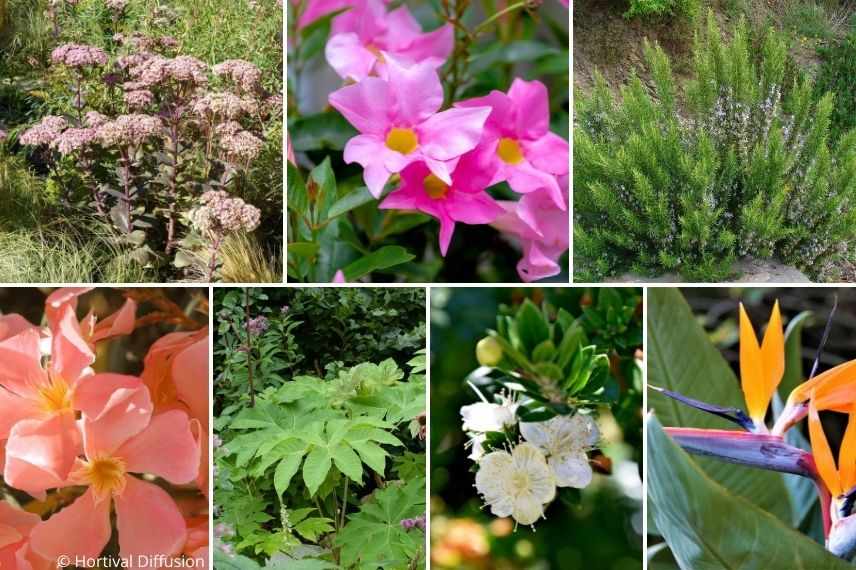
Sedum ‘Matrona’, Mandevilla, Rosmarinus officinalis (photo Wikipedia), Nerium oleander ‘Saumon’, Tetrapanax papyrifer ‘Rex’, Myrtus communis subsp. ‘Tarentina’ (photo Wikipedia) and Strelitzia reginae
For further reading
- Discover our range of dipladenias on our site, along with a selection of exotic plants
- Get inspired by our collection of climbing plants for pots
- Do you enjoy a mild climate? Discover all our Mediterranean plants to accompany your dipladenia
- Need help creating a Mediterranean garden? Follow our 7 tips for designing and succeeding in a Mediterranean garden
- Subscribe!
- Contents
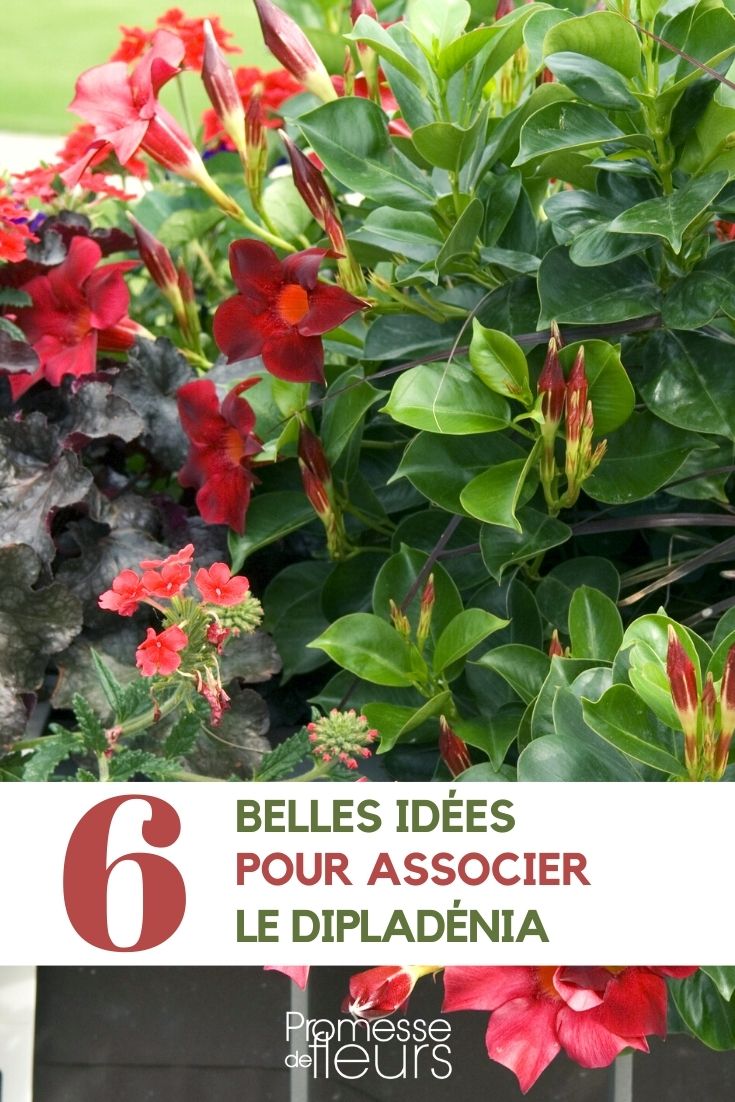


































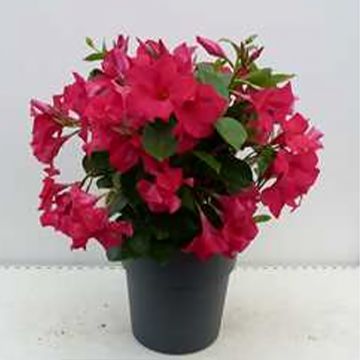
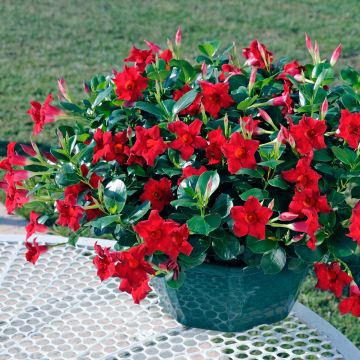
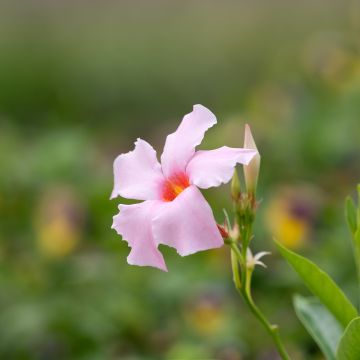
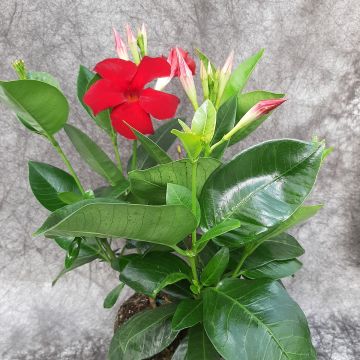
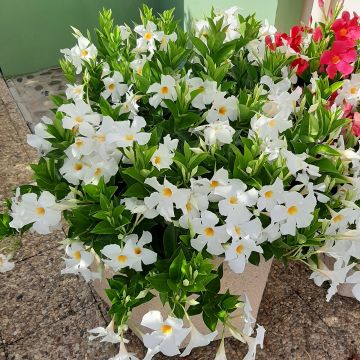
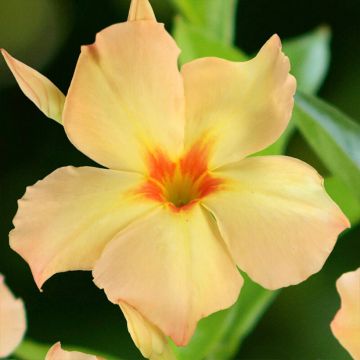
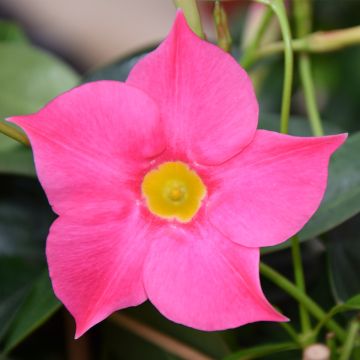
Comments